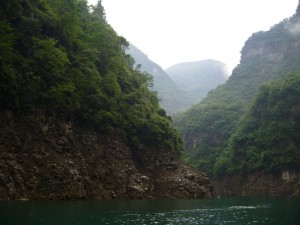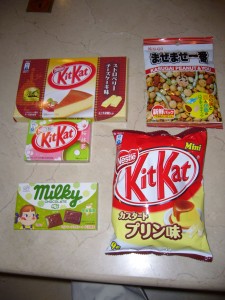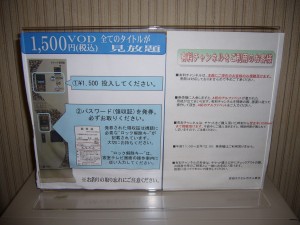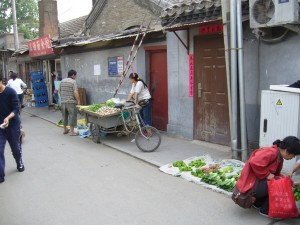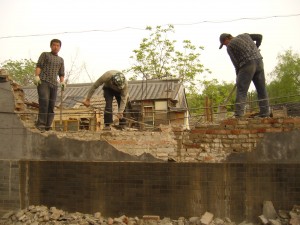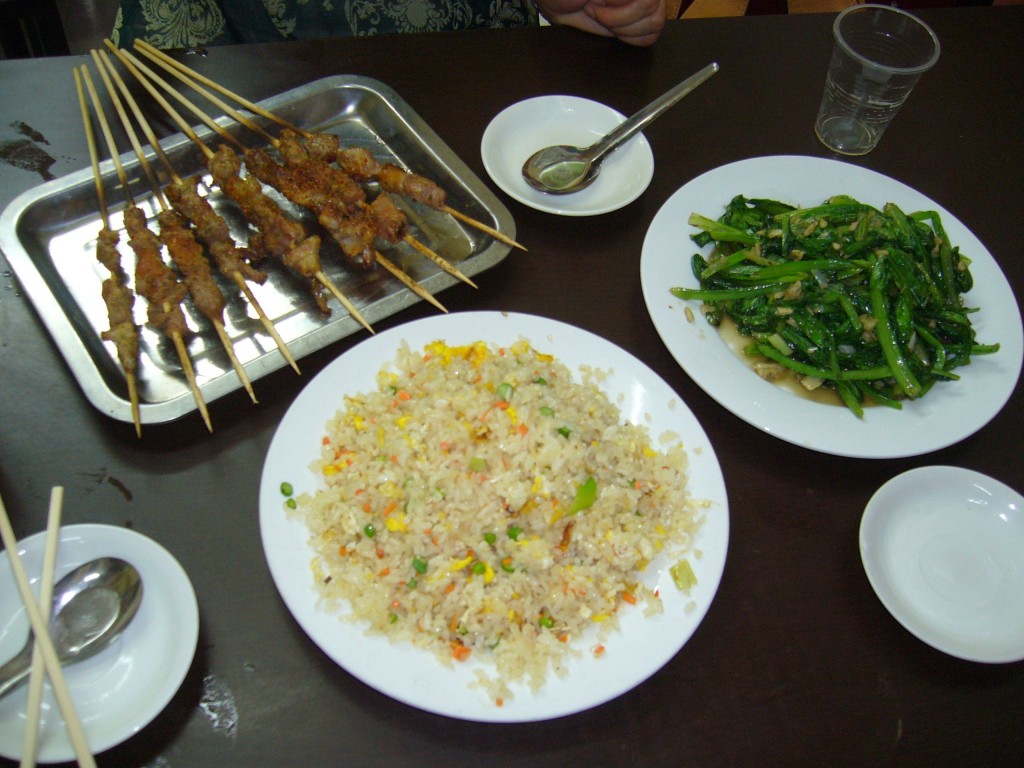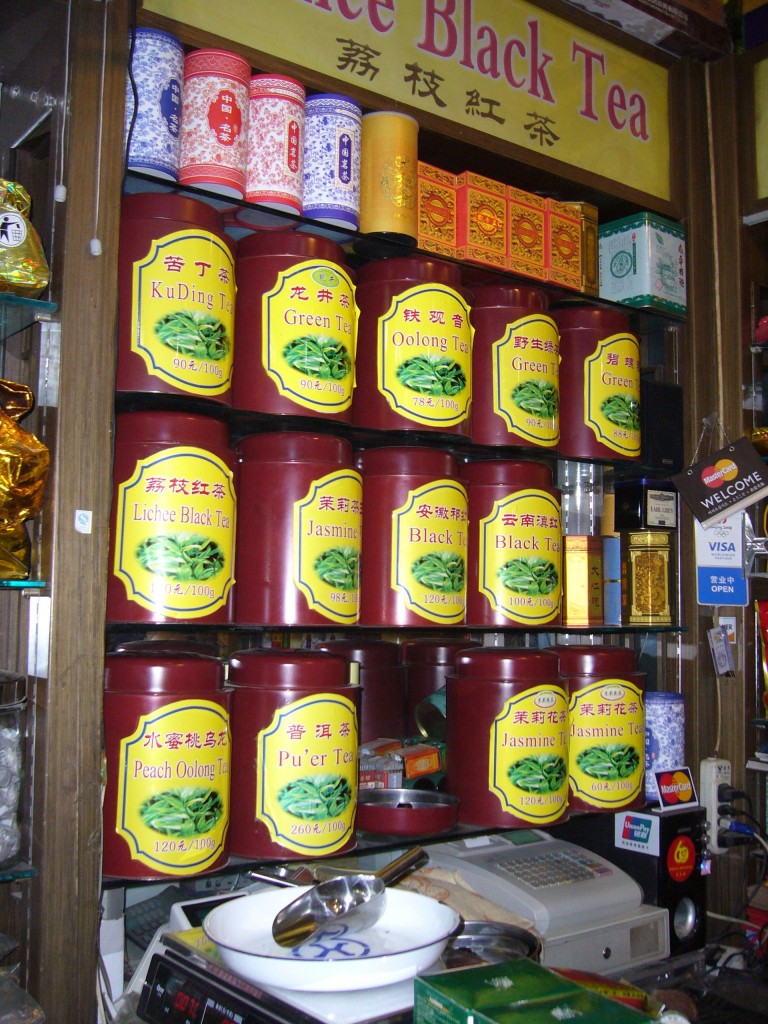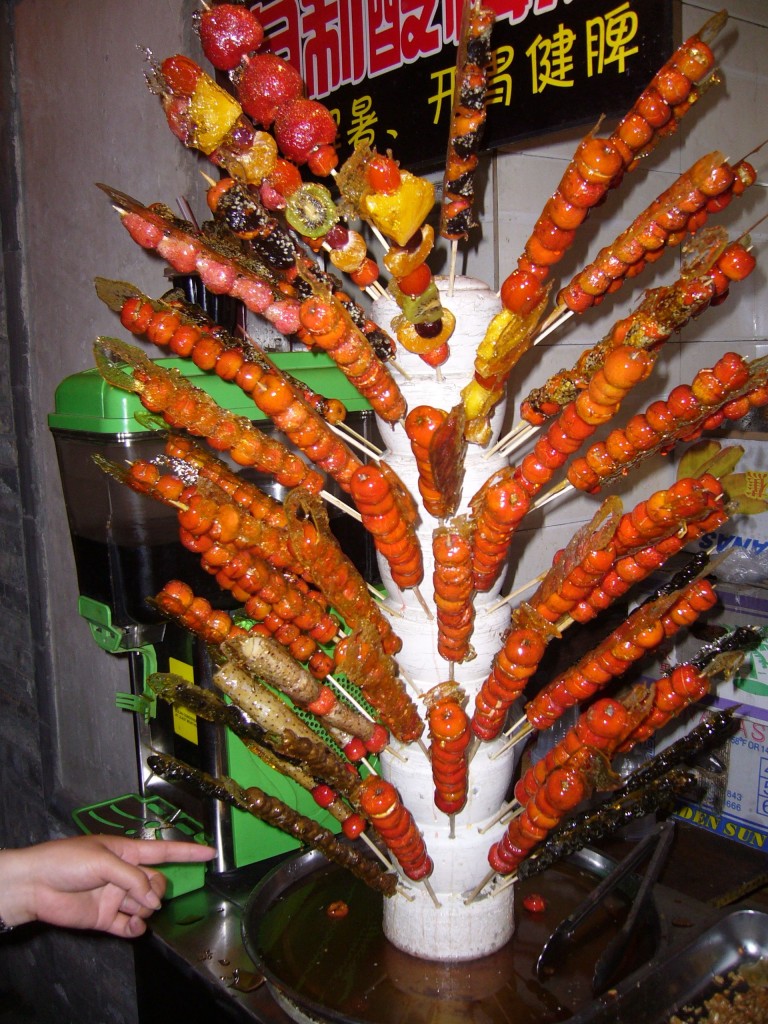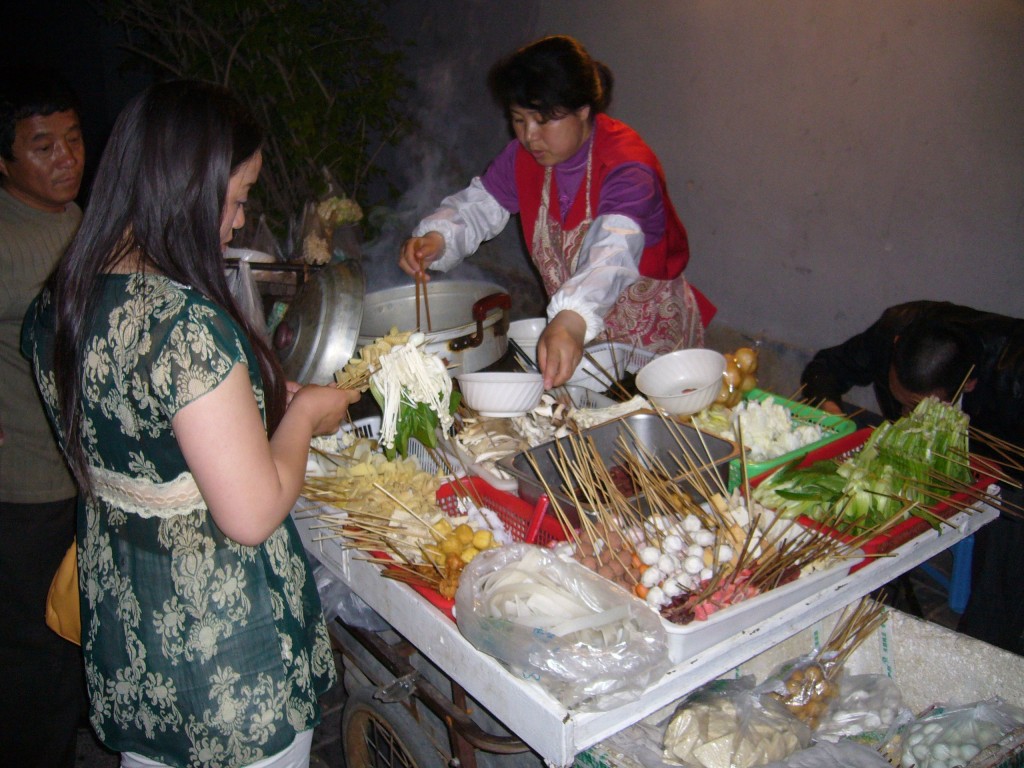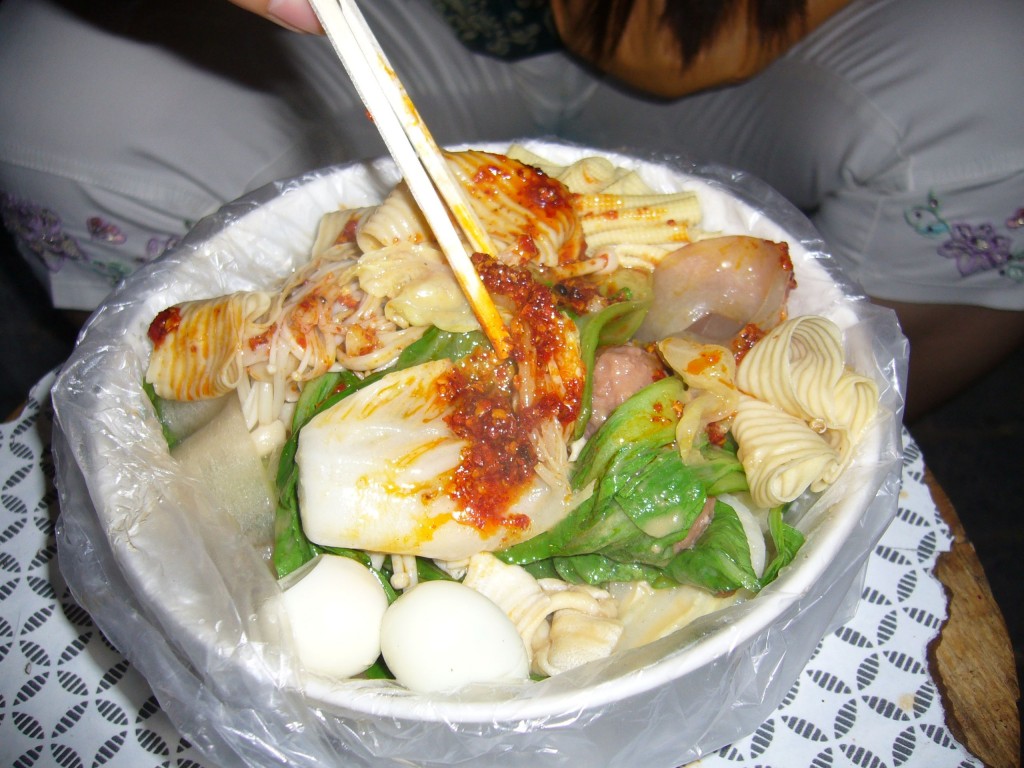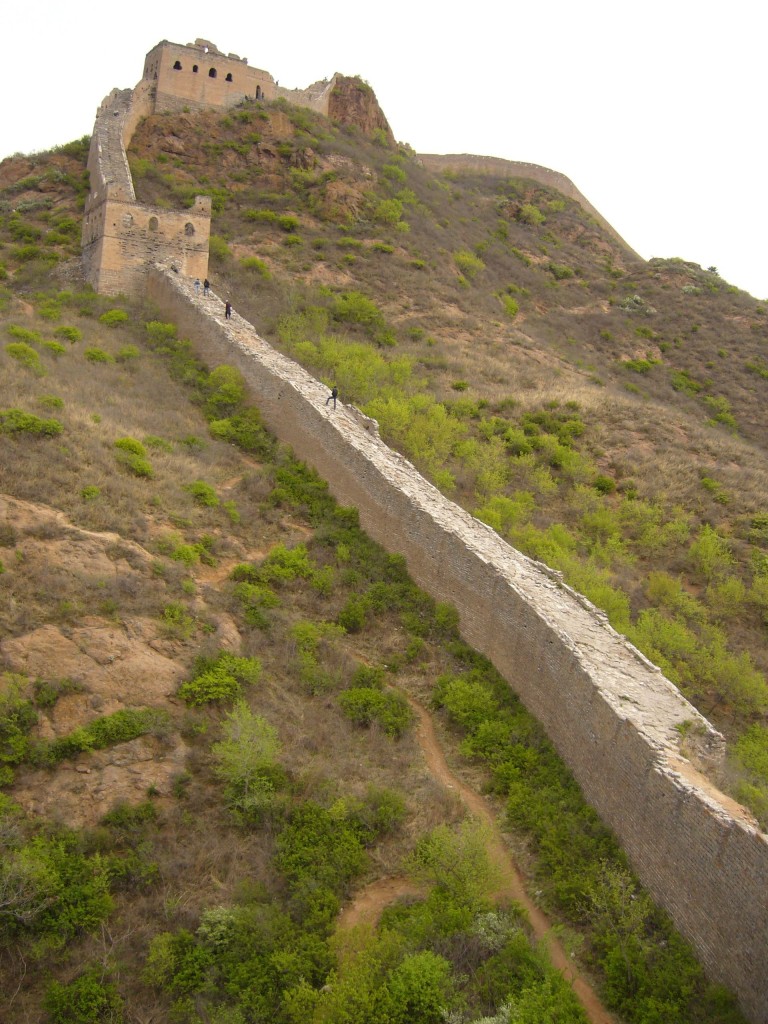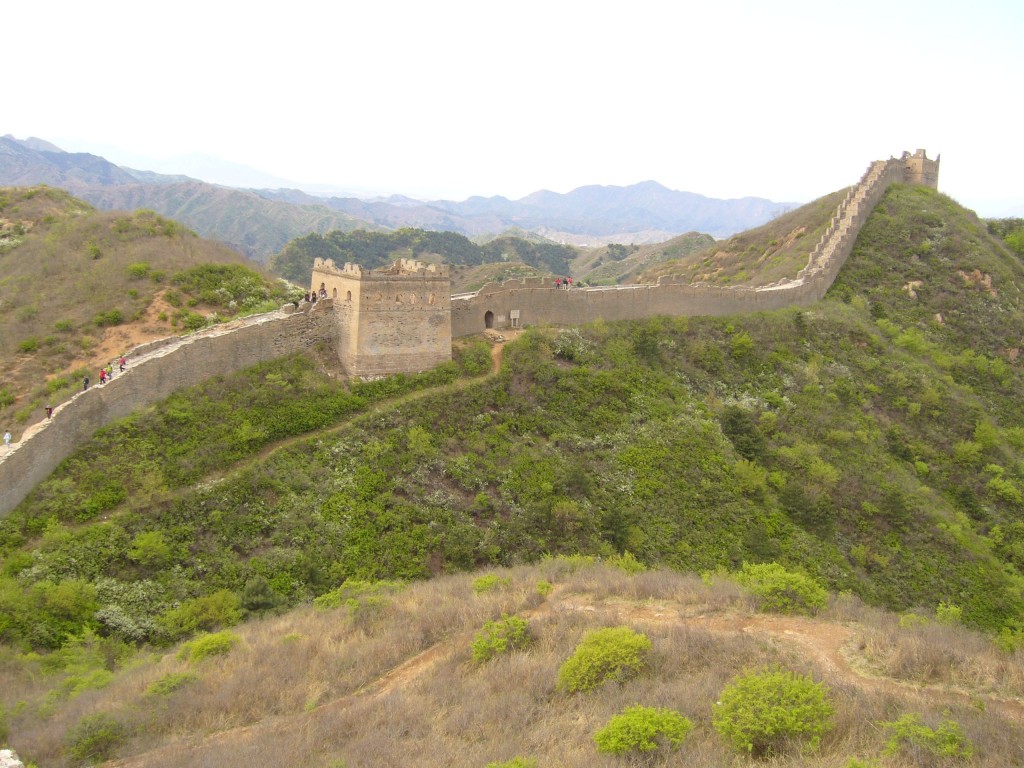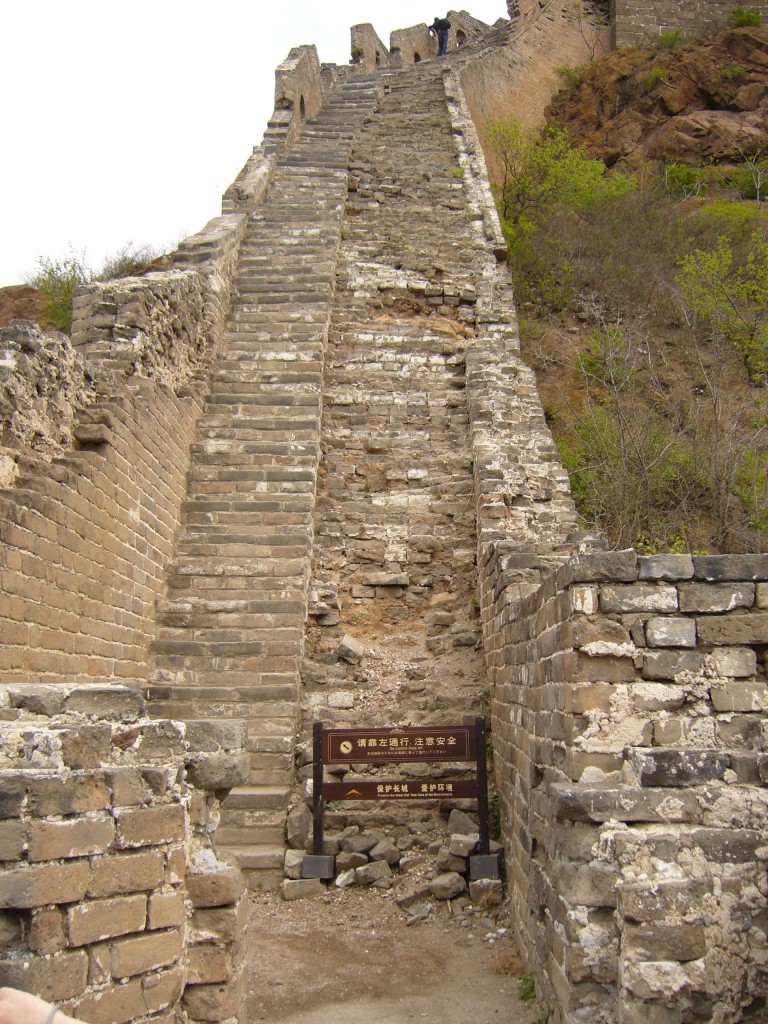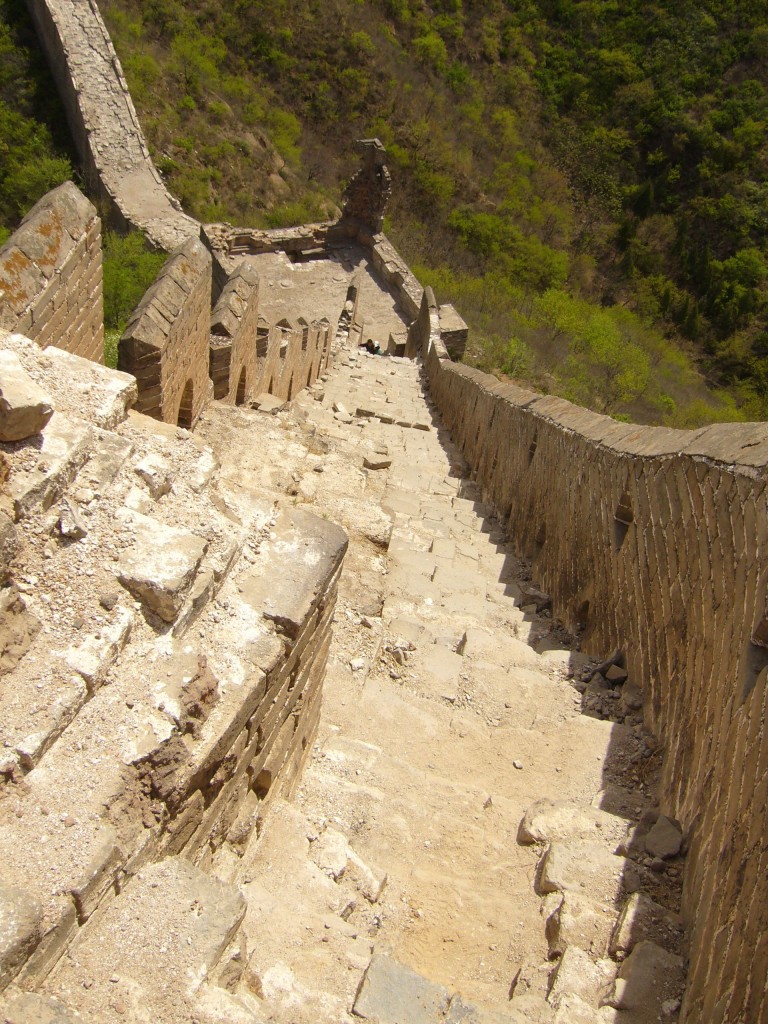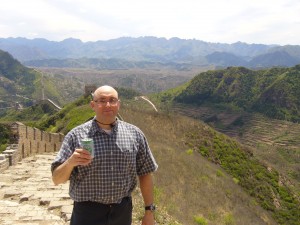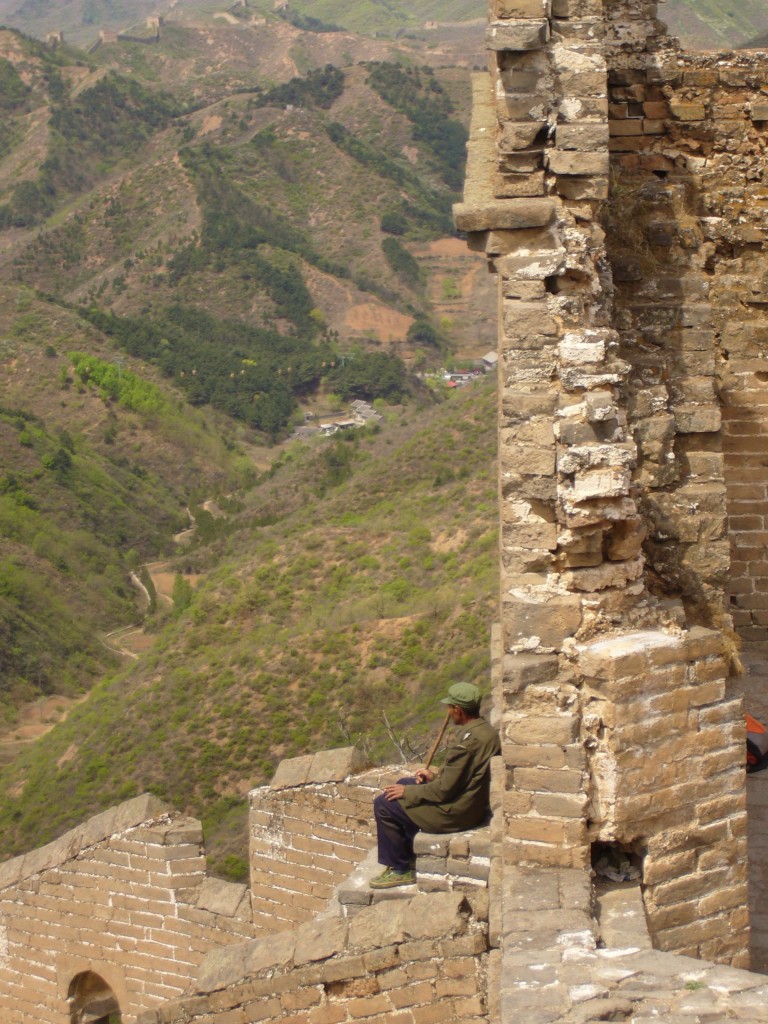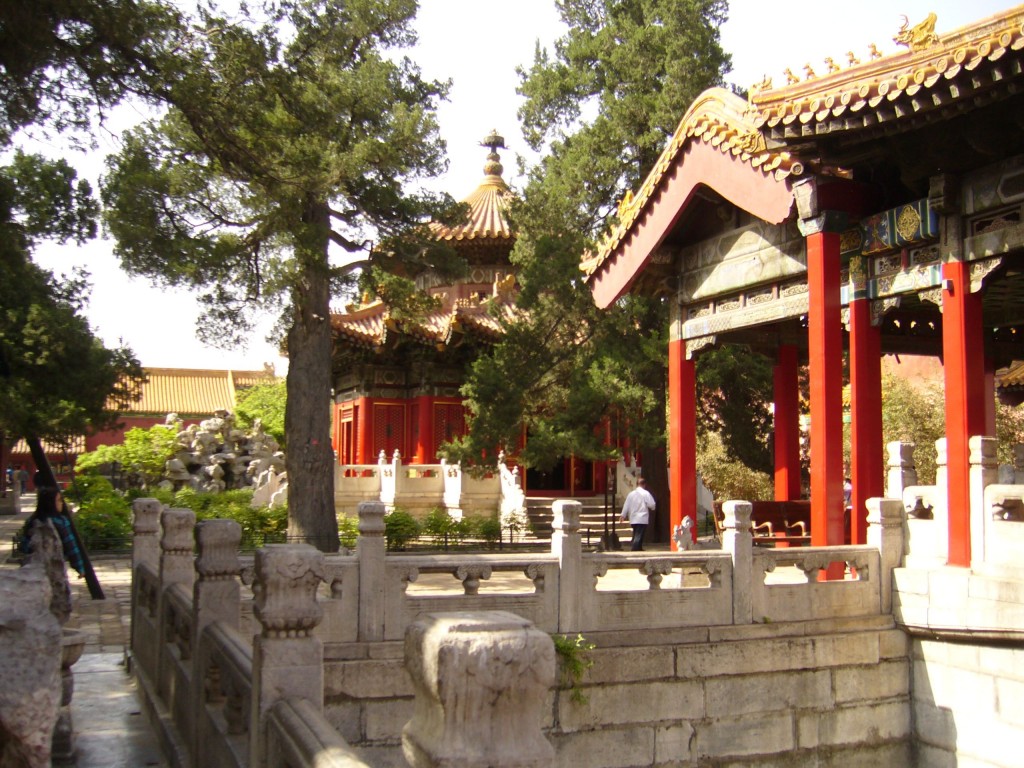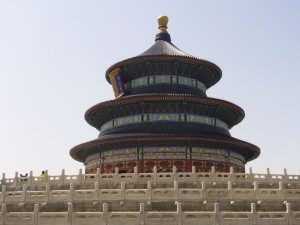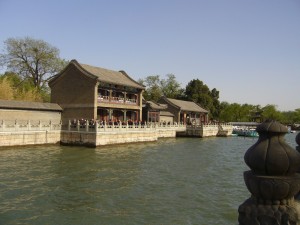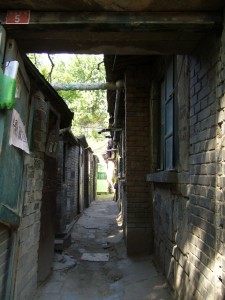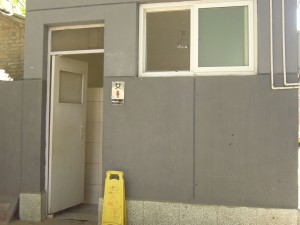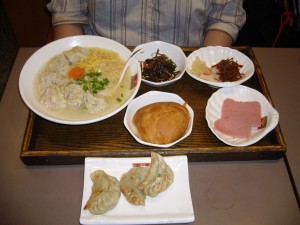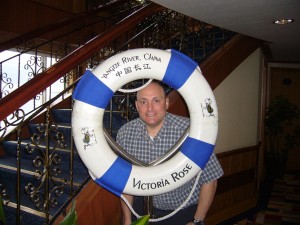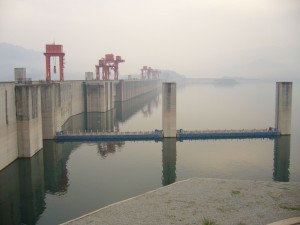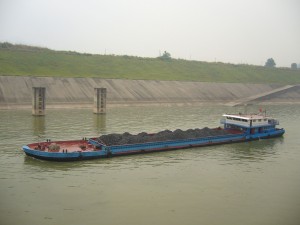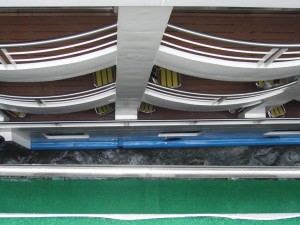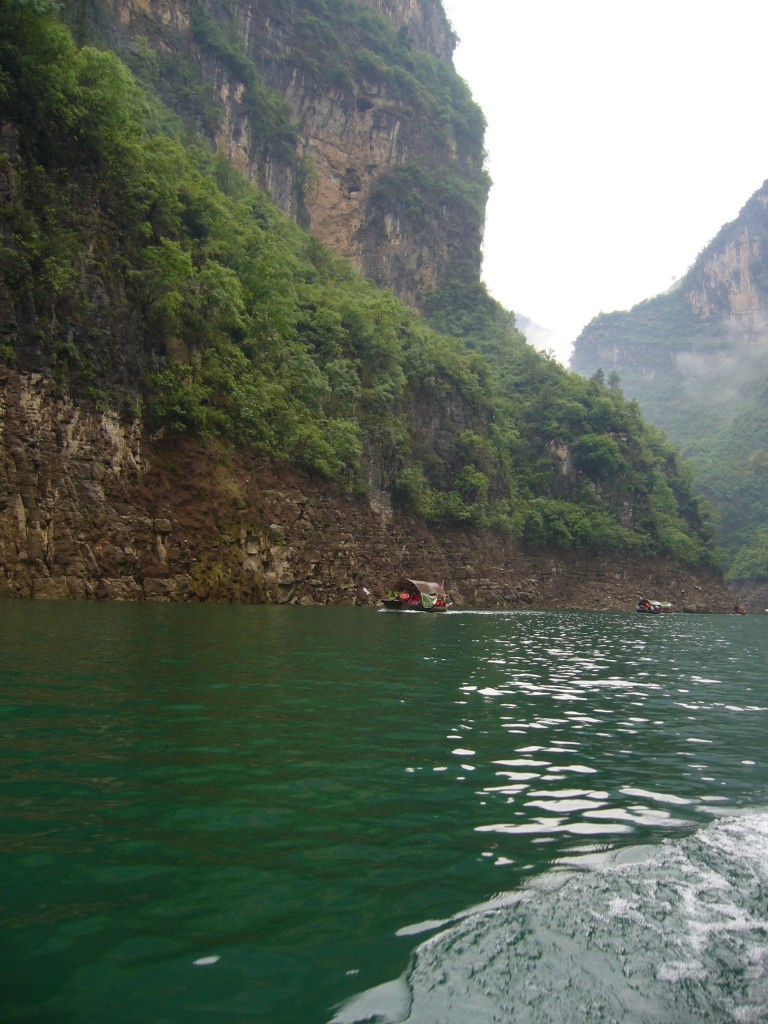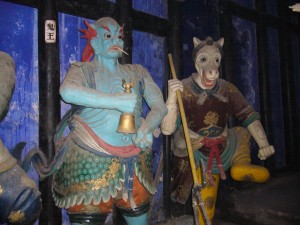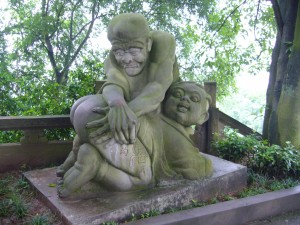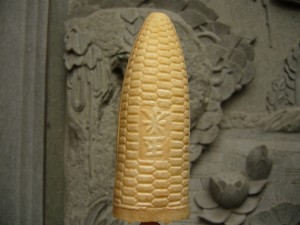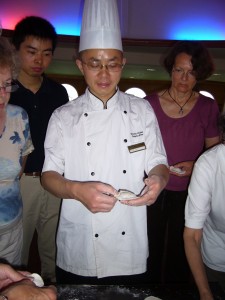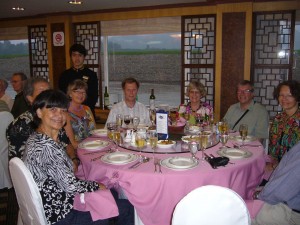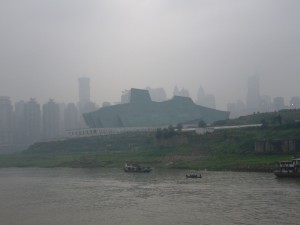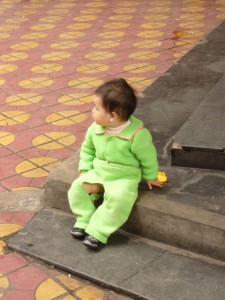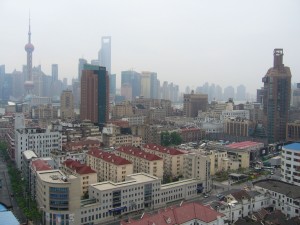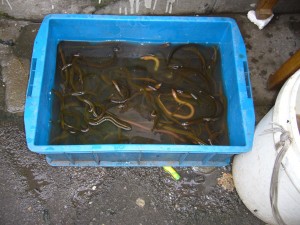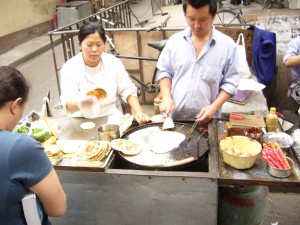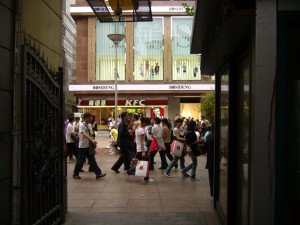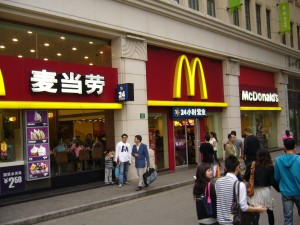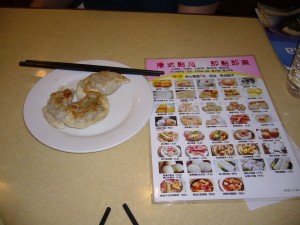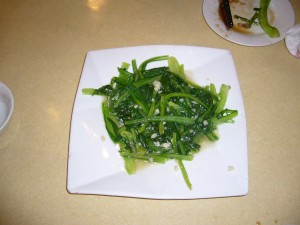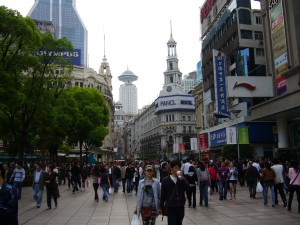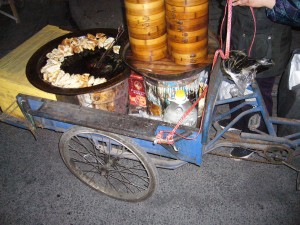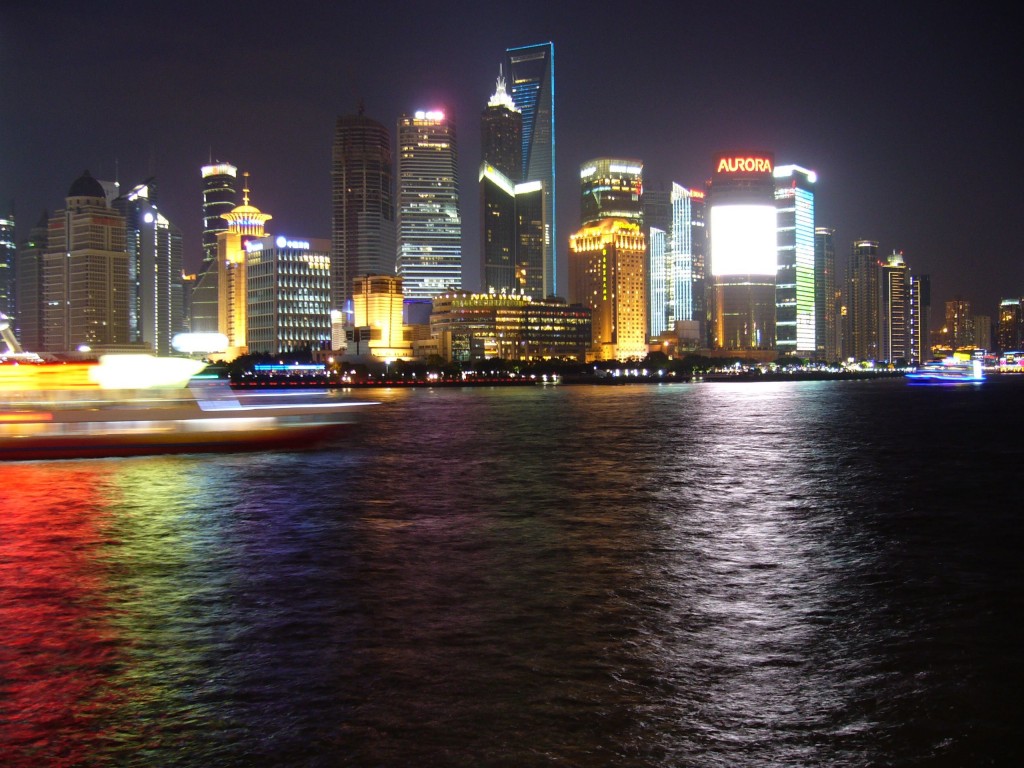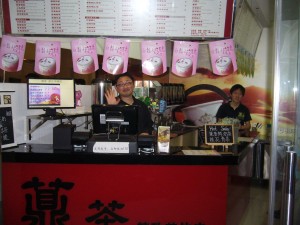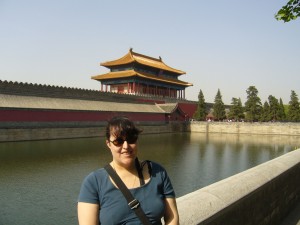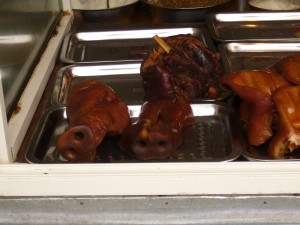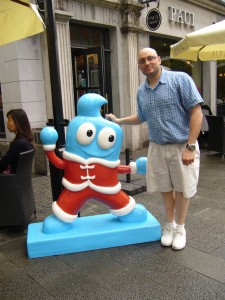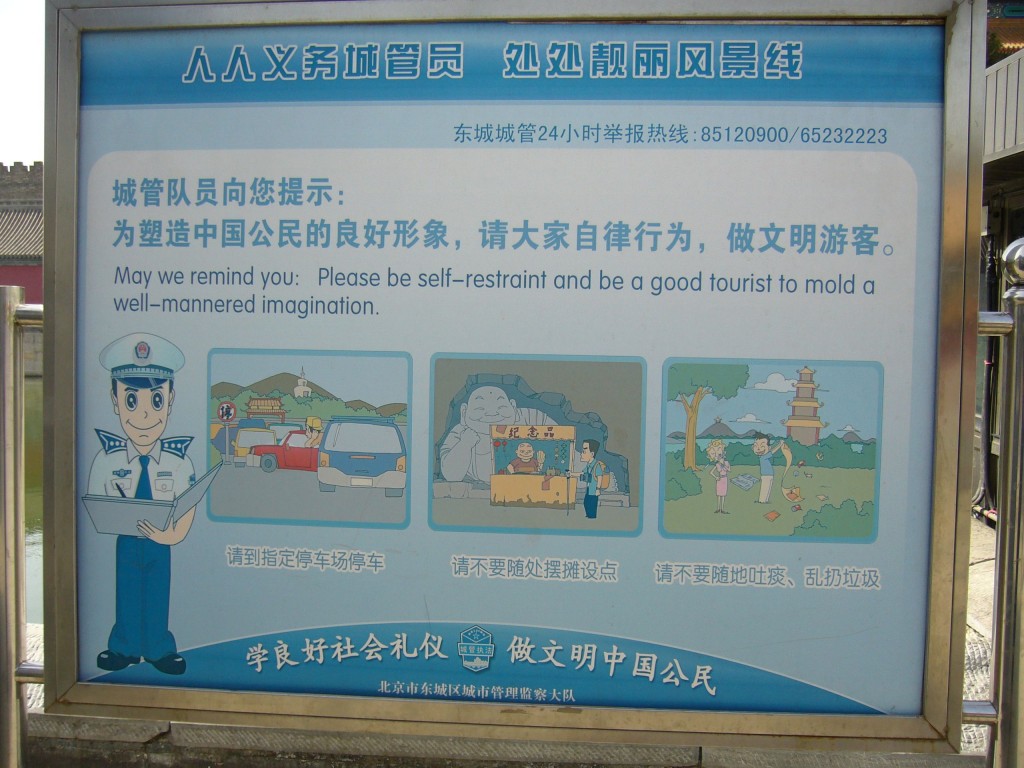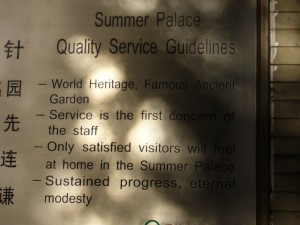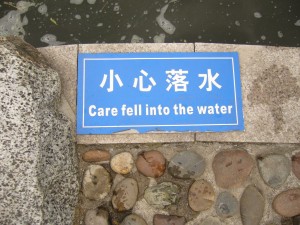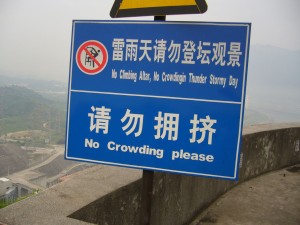China Trip 2010
CHINA TRIP REPORT
We traveled to China in May 2010 with Gate1 Travel (scroll to the bottom of the page for tour details and cost information).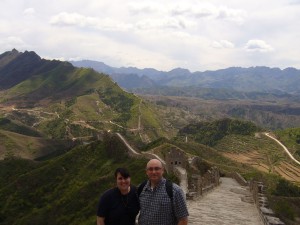
General Thoughts and Tips:
*Things change FAST in China. A guide book published this year was written a year ago, and places, prices, hours, etc. may already have changed. Be aware and plan accordingly.
*Chinese culture is supposed to be tipping-free. No doubt it was until recently. Tipping is not obligatory (and it is definitely not expected in restaurants, particularly small ones), but like all other elements of Capitalism it is catching on like wildfire. Remember that Europeans also don’t tip much, so forget that you are American and don’t be suckered into being the only people that tip (maybe you’ll get lucky like we did and latch onto a group with Europeans who either don’t tip at all or don’t tip much, and then you won’t get duped). Only Americans are expected to tip, and you know what, only Americans have to pay the $130 entry visa fee, so let’s not be total suckers.
*Pack handiwipes and Kleenex packs (you can take a little Purrell, but the wipes are better). You’ll be glad you did
*Tour guides are great at mastering idiomatic expressions (e.g. “piece of cake,” “tip of my tongue,” etc.). Make friends and teach them a new one – they are eager to learn!
*More than 20% of the world’s population lives in China, and we don’t speak a lick of their language aside from a few words learned from a fortune cookie, so I’m not being critical because you can imagine how well you would handle questions from tourists in your pitiful high school level foreign language of choice. I just want to note that although they are making a huge effort at learning English, don’t expect a European level of command of our language (even at a 4 star hotel). Keep your questions as simple as possible and be patient. When you get an answer that demonstrates a nearly total lack of comprehension of what you just said, repeating yourself using different words is unlikely to evoke the response you seek (and raising your voice won’t help, either)
*Apparently the look of horror and slight shake of my wife’s speechless face when staring at a hole in the ground is universally understood, and the English-free cleaning lady in the restroom at the small airport in Yichang gently tugged at her shoulder and led her to a Western toilet a few stalls down. Alas, at the Great Wall we had to share a squat toilet at our lunch restaurant with a stink bug that was swimming along, undeterred by multiple flushes.
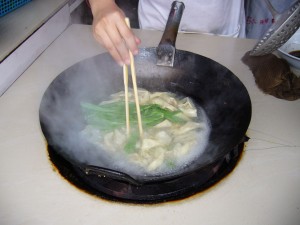
A trip to China is as much about the food as about history and culture, because it IS history and culture. Street food is safe.
*Scroll to the bottom for additional Tips on the Great Wall, taxis, buses, getting around, packing, etc.
*Scroll to the bottom for funny signs in English.
6-7 March
Lost a day of our trip thanks to American Airlines and spent a night in Tokyo. Didn’t have time to do much more than stroll through the Japanese garden and buy some curiously flavored Kit Kats from the hotel shop (green tea, cheesecake, and flan) and other unusual snacks (like fish-flavored rice crackers with tiny dried fish).
We didn’t have any Yen, so we couldn’t get any one of the dozens of different juices and cold teas from the “Vendor Room” on our floor, though there was a Yen exchange machine in the lobby (sort of like a change dispenser at a casino or a Laundromat). Our floor also had a ticket dispensing machine, and we have no idea what it’s for except we saw a Japanese man walking back to his room from that direction with his belt unbuckled (?!).

When someone tells us what sort of ticket this machine dispenses, we'll let you know. Japanese anyone?
8 March
By a stroke of luck we met a tour guide while waiting in line to exchange money at one of the banks in the airport.
The people at the airport tourist information booths have poor English and limited patience, and the free map is next to useless (we got a better one from our hotel to supplement Lonely Planet). Jenny offered to show us the way to our hotel since it was near her apartment, and then she could share a cab with us. We took the 16 RMB express bus (cash only, purchase from nearby counter inside airport) to the train station (took about 45 minutes), and luckily Jenny was able to get a cab for us since it’s a confusing process (cars, even taxis and buses, have many restrictions on where they can stop). The cab was 15 RMB (the taxi touts at the station wanted to charge 50). She waited for us to check in and change and then took us on the city bus #60 (from near the Temple of Heaven, 1 RMB) up to the hutong area and the lakes.
Since we missed our culinary tour of the hutongs we hired Jenny for a very modest price (email us for her contact information), and she entertained us the whole night. We walked along Gulou Dongdajie area and Hohai Lake. They alleyways of the hutongs are still populated by families, but times are rapidly changing and this area already has many trendy shops and eateries (the hutong near our hotel is still not too developed but surely is on its way). We tried a variety of street snacks, like a pulled pork sandwich Jenny said was a “Chinese hamburger”, a scallion pork roll, boiled fish and beef balls (much tastier than it sounds). Dinner at a small place populated by slightly rowdy youths filling up on 4 RMB litre bottles of beer. We had a variety of BBQ’d meat skewers cooked over a wood fire, and really delicious fried rice and garlic greens. With two large beers it all came to just 36 RMB (about $6) for the three of us.
Nightlife along the lake is active and fun. Families, singles, couples, everyone out on a Saturday night, mostly Chinese and not a lot of tourists. We stopped at a tea shop, and the owner spent a long time telling us about the tea and giving us samples (we tried about a dozen) before we settled on buying some ginseng oolong and fruit tea (very high quality with Western prices to match, but we later found that prices for good quality tea is high all over, even in street markets and local/non-tourist shops).
Dessert later was a bunch of candied fruit on a stick, very sweet and good and less than a dollar.
Jenny then took us to a hot pot cart. You pick whatever you want, 1 or 2 RMB a stick, and then they cook them up. I don’t know what they put in there, but it’s spicy and really delicious.
9 May
Breakfast in our hotel is the usual German mob scene, so they sent us over to the (better) Chinese side. Mix of Western and Asian food but terrible Lipton tea (which we had for breakfast everywhere else on the trip, too), and we carbo-loaded on the amazing fried rice for our 10 km hike on the Great Wall.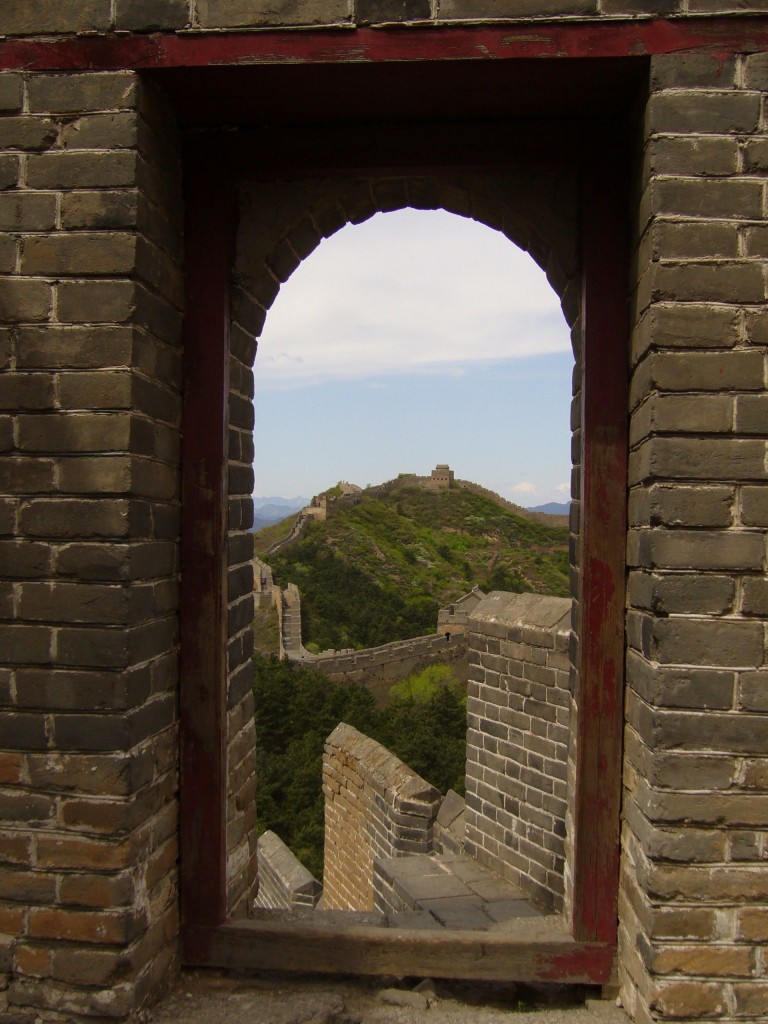 We hired a private tour through China Art International Travel Service Co.,Ltd. (CAITS) so we could go at our own pace and avoid being taken on any shopping excursions. All our booking was done through email, and we were able to pay in US Dollars on the day of the tour. They responded to us immediately and were really friendly and efficient. They do airport transfers for less than $25.
We hired a private tour through China Art International Travel Service Co.,Ltd. (CAITS) so we could go at our own pace and avoid being taken on any shopping excursions. All our booking was done through email, and we were able to pay in US Dollars on the day of the tour. They responded to us immediately and were really friendly and efficient. They do airport transfers for less than $25.
Iko our guide was friendly and full of information. At Jinshaling we had a local wall guide to escort us. I guess we had imagined the hike would be like the photos you see of the Great Wall at Badaling (where most tourists are taken), where the wall is mostly repaired and smooth.
We walked more than 6 miles along steep steps, loose bits, and slippery rocks.
The hawkers selling beer, water and trinkets climb up there every day, and I guess they earn the high mark-ups (had to have a cold beer for $1.50 after about 5 miles, more than triple to store price but worth it and mostly thirst-quenching water anyhow).
For anyone who can handle this walk, it is terrific. Not many people take it on, so the vastness of the Wall spread out in the countryside is intense.
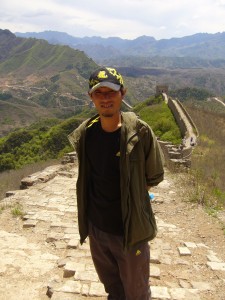
Our Wall guide walked the whole way with us without exerting any effort or taking so much as a sip of water.
Anyone who is super exhausted at the end can take a zip line back to the parking area in Simatai (and one buy was smoking while riding down). Visiting Simatai is another option to see the great wall – it’s more restored and easier to walk around yet doesn’t suffer from as many crowds as Badaling (we would not recommend walking from Simatai to Jinshaling since the hike would then end in the most difficult part, once already exhausted). Too tired for dinner.
10 May
We woke up sore from the Great Wall hike. Slow crawl through Beijing traffic with our small tour group to reach the Forbidden City. Like with the other tour, we booked a city tour entirely through email with Beijing Xinhua International Tours, and we were able to pay in US Dollars on the day of the tour.
They responded to us right away in perfect English. They left a message at our hotel and phone us in our room the night before to confirm the pick up time. The Chinese tourism industry is really well organized.
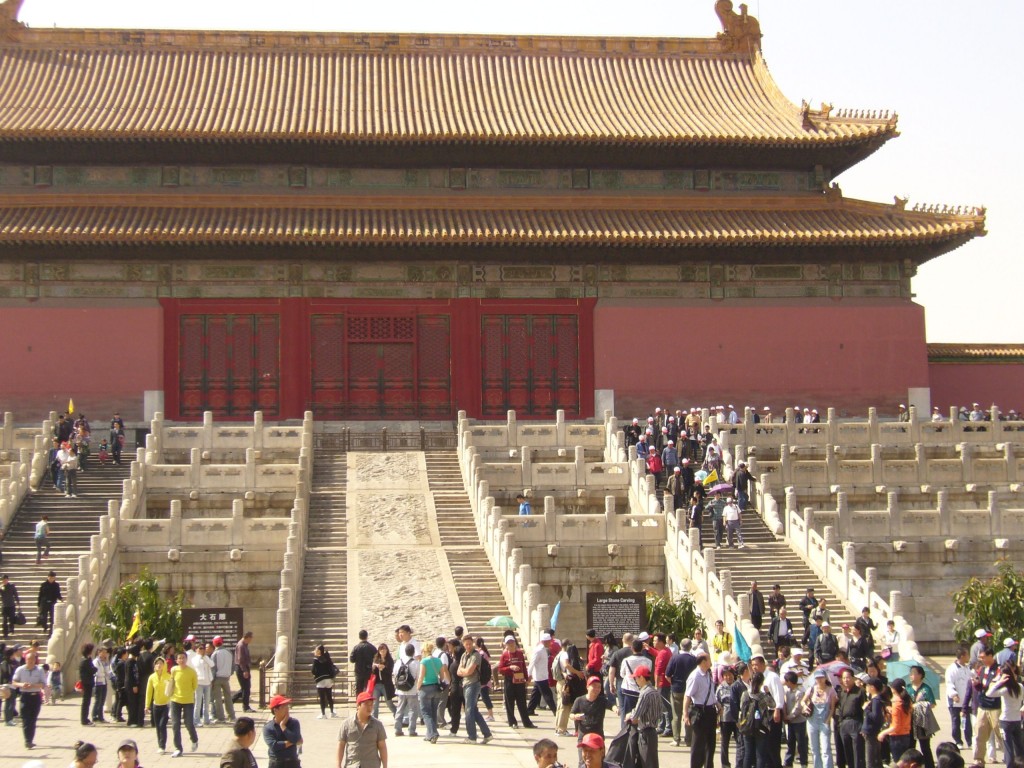
Tourists from all over the world visit the Forbidden City, but the majority of visitors are Chinese.
At the Forbidden City, to minimize exposure and damage, no one can walk inside any of the palaces and temples, and it is very difficult to see inside (partly because of the pushing crowds). But the main thing to see is the vastness of the city itself. It’s about 2 km from end to end, and we walked around on our own for a couple of hours, meeting up with the group outside Tianamen Square and taking requisite photos of the giant Mao poster.
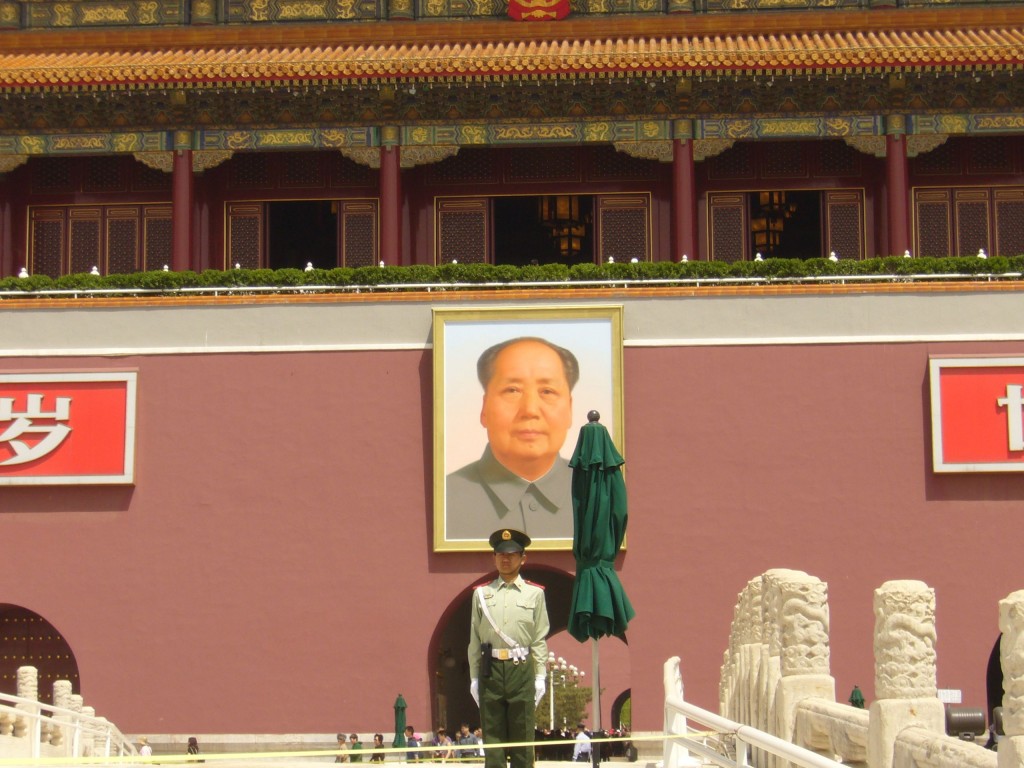
The iconic Mao poster. Since we lost a day of our trip due to an airline screw up, we missed the opportunity to visit his body.
Our first factory tour of the trip to an old pharmacy (allegedly used by the emperor). The “doctors” inspected everyone by asking questions and having everyone stick out their tongues. Everyone in the group (American, German, and Indian) was prescribed #8, which is supposed to aid with losing weight, full of heretofore unheard of ingredients and just $120 for a month long supply (take 20 pills a day).
Family style lunch was quite good, about 10 dishes on a giant lazy Susan. Scallion egg pancakes, the famed squirrel fish we’d read about (a crispy sweet and sour fish cut up to look like a squirrel), lamb, Kung Pao chicken, local beer… Bought a knock off Sportsac MP3/cell phone case for 10 RMB and a poor quality, but amusing, Red Army hat (complete with Mao pins, for $2 USD).
Temple of Heaven has hundreds of retired folks playing cards, doing Tai Chi, dancing, playing games (like kick the hackey sack with a badminton feather tied to it) and just hanging out smoking and chatting. Then another factory visit to a pearl factory (at least it had a clean bathroom, and at just $30 for a full day tour including all admissions it was worth the waste of an hour, since we just rested anyway – admission to Forbidden City alone is $9, and a large lunch was included).
Last visit of the day to the Summer Palace, which is huge and very beautiful, set on a man-made lake. Chinese tourists took pictures of me, I think because of my wide-brimmed hat maybe they thought I was a bald cowboy.
Dinner in Beijing was at a well known but reasonably priced restaurant near the hotel, Bian Yi Fang. The best part is the waiter showing you how to roll up the duck in a pancake with scallions and plum sauce, and of course the dried up half a duck head served on a saucer (half a duck head means sliced from the top so you can see ½ the brains, etc.).
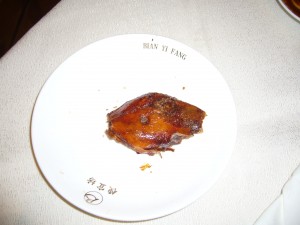
Peking duck at Bian Yi Fang. We ordered 1/2, so they only brought us 1/2 a duck head on the platters. They sell the bills separately as a menu item which is why the bill is cut off.
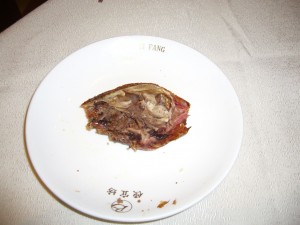
Duck head half flipped over. They taught us how to put together our duck burrito, but there was no explanation of whether we were meant to eat the insides of the head.
Our bed is the first of several hard beds, and the pillows aren’t too soft either (so we’re using our neck pillows that we use for flying).
11 May
Walk to the famous Pearl Market only to discover that it doesn’t open until 9:30 (Lonely Planet says 8:30). So just walked around the hutong and missed a photo op of a bunch of bald kids (martial arts students) crossing the street.
Ride to airport and a big noodle soup lunch that comes with a side of Pringles, seaweed appetizers, shredded vinegary beef, slices of Spam derivative, and a greasy, stale bun. Soup was good though and okay jasmine tea and dumplings. Ice cream bar for just 2 RMB with an oatmeal center. Airport shops sell bagged duck (or duck parts).
Flight to Yichang and a drive through the fertile, agricultural airport. Our guide Gracie has a great command of English and mastery of idiomatic expressions. Stop at an embroidery factory, which was actually interesting and some of the work is excellent. Taken to the cruise dock to board the Victoria Rose cruise ship. We walked up to the town at sunset for nice views of the gorge. The boat is a little old, but is pretty clean and comfortable (well, the bed is rock hard and the only English tv channels don’t work very well).
12 May
First shore excursion is to the Three Gorges Dam. It’s massive, but because it’s longer than it is tall it’s not all that exciting. There’s a huge gift shop, of course, and we bought some sesame biscuits filled with peanuts (we think).
Going through the locks takes hours and is interesting to watch. We see lots of boats, particularly lots of coal barges, going up and down the river.
13 May
Wushan and the Little Gorges today.
Very beautiful, even if the experience is rather Disney-fied (with folk singing, goofy costumes – see photo–, and whatnot). 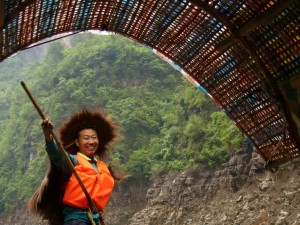 We could see one of the legendary hanging coffins on the way back, but it’s very high up the mountain and difficult to see. Back on the ship we overslept the free Chinese lesson. There was a goofball variety show (with a magician, Chinese dragon, trumpet player, dancers).
We could see one of the legendary hanging coffins on the way back, but it’s very high up the mountain and difficult to see. Back on the ship we overslept the free Chinese lesson. There was a goofball variety show (with a magician, Chinese dragon, trumpet player, dancers).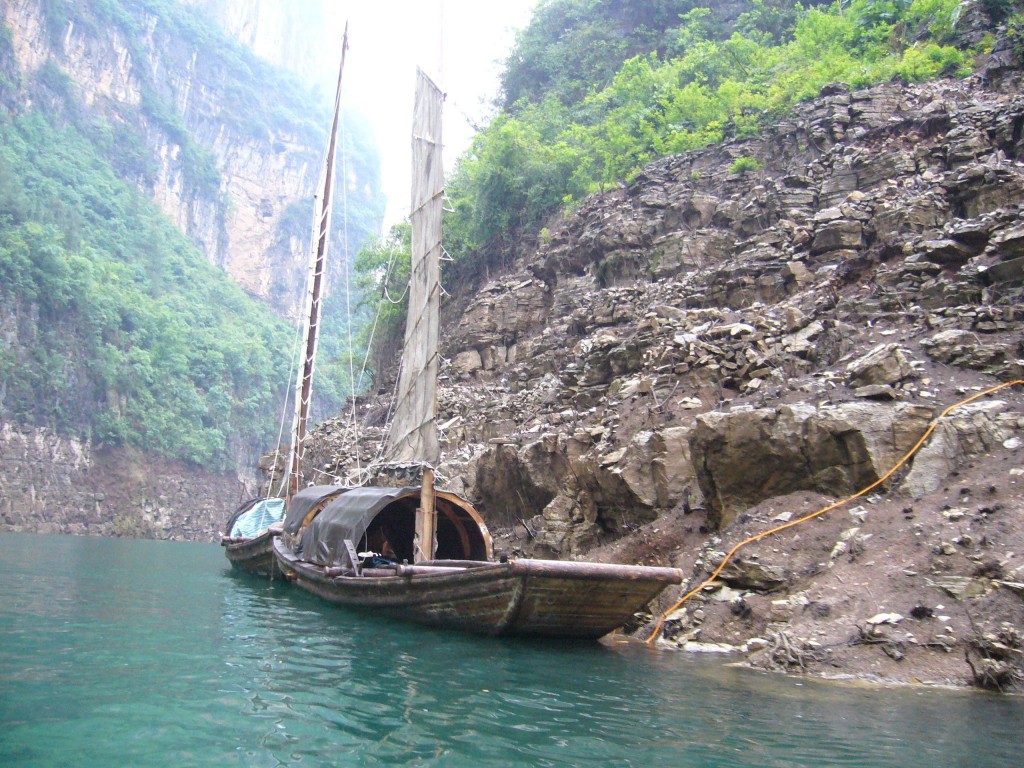
14 May
Tai Chi lesson this morning before breakfast, making we want to get a silk pajama outfit. We noticed that when the ship docks all the crew walks down a long ramp to get food from local vendors (like we have noticed in Miami), and we bet the food there is great.
Excursion to Fengdu, the ghost city which was relocated to higher ground when the river was flooded for the dam. Temples, shrines, and all that sort of thing, including lots of junk for sale.
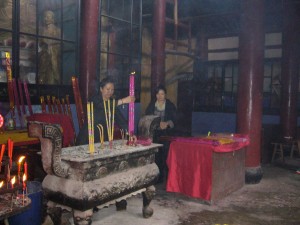
This fertility temple gets a lot less business since the implementation of the one child policy in the 1980s.
We purchased corn-shaped (and flavored) ice cream, and even though we were told that the one thing you don’t bargain for in China is food I managed to get them to knock the price from 10 to 5 RMB.
Afternoon tour of the ship’s bridge and a dumpling making lesson.
Since we’re teaching a dumpling class at Newton Community Education next winter we took lots of notes and pictures. We didn’t get to eat the dumplings we all made because of “health and sanitation codes” – any visit to any food market area in China will demonstrate the humor of this situation.
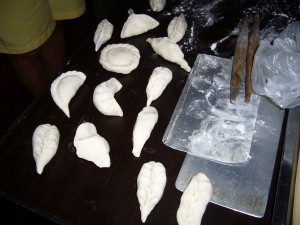
Can you guess which were made by the chef and which by the passengers? China has 100s of dumpling shapes.
15 May
Dock in Chongqing (pronounced Chongching) and disembark. There’s an odd, massive elevator from the dock up to the city (and people smoke in it, in front of the no smoking sign).
This city is less modernized than others. We see kids with slits in their pants that we were told about (diapers are too expensive, so they potty train early and this simplifies things).
Even though China isn’t supposed to be a tipping culture the bang bangs (men with bamboo yokes) are trying to double dip for tips (Gate1 escort paid them directly, and anyhow our bags are light and we would have preferred to just carry them ourselves).
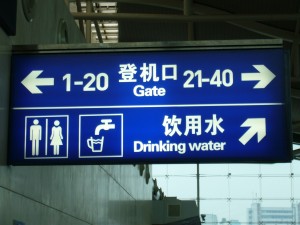
The drinking water at the airport is boiled. But that means it is also hot. There's nothing more refreshing than a cup of hot water.
Revolting meal on our flight to Shanghai. The Shanghai Airport is new and clean, and there’s a high speed Maglev train that takes just 8 minutes from the eastern part of the city. Our Bund Riverside Hotel is very nice and clean, and we have a view of a tributary to the river. We walked for hours around the city.
Near the hotel is a local food street, bustling with fish, turtles, snakes, birds (all for sale to eat, but currently live).
One man is walking holding several upside-down live chickens while another lady is trying to corral a bunch of live ducks into a burlap bag.
The lady de-boning (?) little snakes and then weighing them doesn’t seem too enthusiastic to get her picture taken. We bought fresh scallion cakes (2 RMB) and scallion omelette-like things (5 RMB) from a cart, which are delicious, and also spicy mushrooms on a stick.
East Nanjing Road is just a block away and modern with expensive stores and Western fast food (McDonald’s, KFC, etc.), which is such a typically Chinese contrast within a 1 minute walk.
Stopped for vegetables and potstickers at another food place, all excellent.
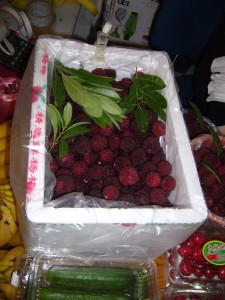
Waxberries. Notice the little cherry boxes in the lower right, which are inexplicably expensive in China. Now we understand why Chinese people attack cherries for sale in American markets like brides at the Filene's sale.
Bought some fruit we’ve never seen before, something one guy with a computerized language translator identified as “waxberries” (with a pleasingly fuzzy texture) and another plum type of thing. Bought some milk tea, sweet potato flavored (which turned out to be what we call Taro). Got some red bean, squishy sweets at a fancy shop we never managed to find again and then more noodles.
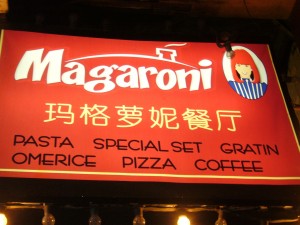
Explain to us what Little Debbie is doing in Shanghai selling Italian food, gratin, omerice and special set?
At No. 1 Shanghai Food Store we walked through many floors of all kinds of foods, local and imported. Everyone in China seems to go cuckoo for lardy cookies, we have no idea why.
16 May
We took the subway (3 RMB, ticket dispenser easy to operate and with an English option – tickets must be retained for exit like in London or D.C.) to the stadium to catch a tour to the water villages. Lonely Planet is grossly erroneous about the frequency of tours, and they are all sold out. The only available tours are too far away, but no big deal since we have plenty to see in the city.
The French Concession area also has many fancy shops. We stop for delicious taro-filled bread at Ichido (fancy but inexpensive). Lots of Western shops and restaurants, and lots of new construction. We visited the Communism Birthplace Museum (our name, actually called Site of the 1st CCCP Conference), which is free and has a clean bathroom. The gift shop sells a watch of Mao waving his arm.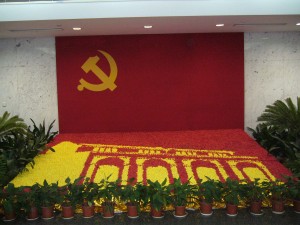
Lunch back in the Bund at Top Dumpling, with one really good soup and one yucky one. Then we “splurged” on foot massages at Sunny Massage, a Japanese owned place. There are lots of foot massage options in Shanghai, some for just a few dollars. But we paid about triple the price (about $15 USD, including a tip) to go to this great place.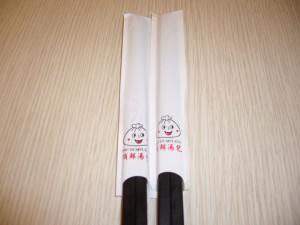 There’s a room for just the two of us, and they bring us tea and biscuits to snack on while our feet soak in water with flower petals. Then we get a neck and shoulder massage before they tackle our aching feet. We were tempted to just pay for another hour. Excellent and worth every penny. Their website was not operative at the time we visited, but they are centrally located in the Bund/Huangpu District, 251 North Guangxi Road at the corner of Hankou Road.
There’s a room for just the two of us, and they bring us tea and biscuits to snack on while our feet soak in water with flower petals. Then we get a neck and shoulder massage before they tackle our aching feet. We were tempted to just pay for another hour. Excellent and worth every penny. Their website was not operative at the time we visited, but they are centrally located in the Bund/Huangpu District, 251 North Guangxi Road at the corner of Hankou Road.
Stopped at a milk promotion exhibit out on a plaza. As China westernizes they are really getting into milk (though we didn’t see any cheese on our trip) – it’s a bit bizarre. More walking nearly wipes out the benefit of the massages, so we need to rest again.
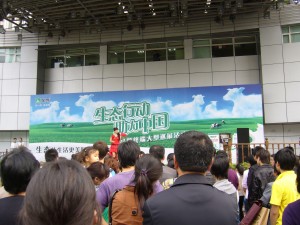
Can't understand a word, but this appears to be a magic show pushing the concept of milk to a nation of one billion lactose intolerant people.
Evening stroll to the riverside. People are in town for the World Expo, and it’s a mob scene on a Sunday night. We get excellent street food a few blocks away, and while we’re eating we see a policeman counting out money and a woman selling counterfeit Expo logo stuff.
We don’t know if she’s bribing him, or if she’s paying a fine, or if the police is buying stuff off her. But we bought some keychains off another guy while the police was distracted (we did buy some stuff in an officially license store, too).
The riverside is incredible. Across the river the buildings are all lit up.
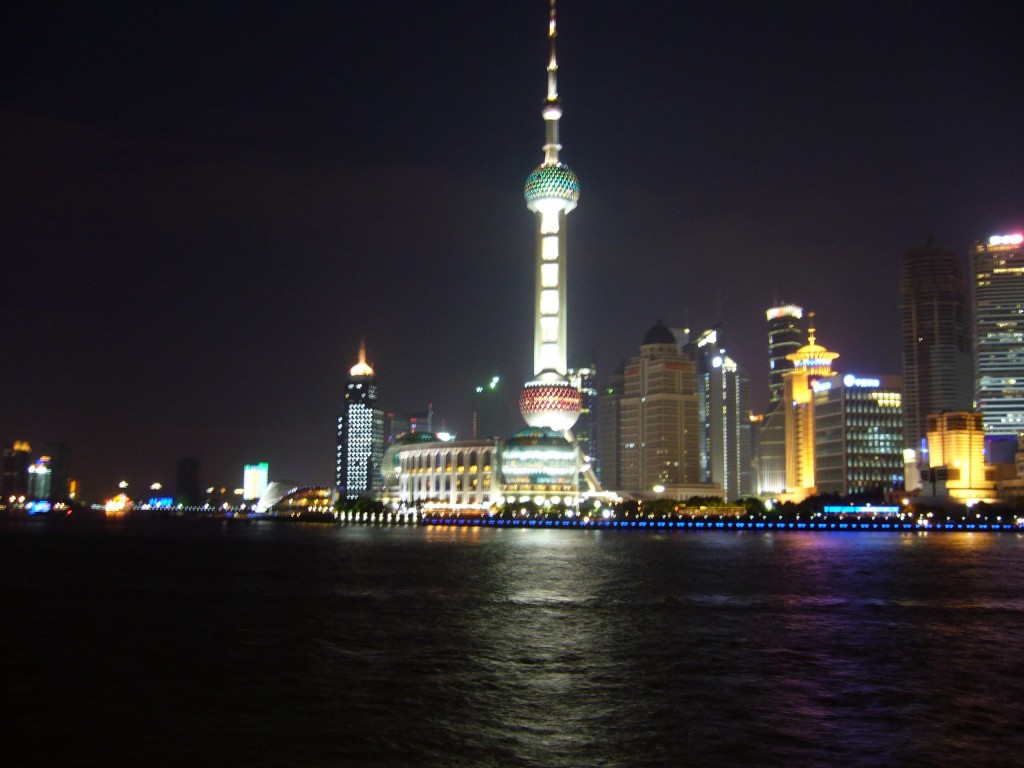 Where we are thousands of people are walking around, just enjoying life. The Bund has a lot of European architecture, and many brides and fashion models are having photos taken. On the walk back to the hotel we take photos of our accordion playing Chinese brethren.
Where we are thousands of people are walking around, just enjoying life. The Bund has a lot of European architecture, and many brides and fashion models are having photos taken. On the walk back to the hotel we take photos of our accordion playing Chinese brethren.
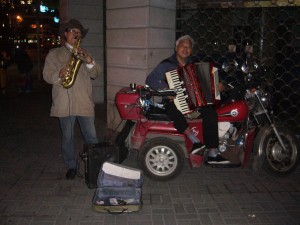
We didn't see too many buskers in China, but I guess they heard Italian-Americans coming and pulled out the accordion.
At no time during this trip have we ever felt unsafe, even walking around quite late at night.
17 May
Our last day in China. We walked through People’s Park (significantly nicer than its Berkeley namesake) to the Shanghai Museum. A bit of line outside to go through security. As luck would have it there are two Italian exhibits inside (being viewed by the only Italians we’ve encountered on this trip). One is an exhibit about Matteo Ricci, a 16th century Jesuit missionary. Excellent and interesting. The other is works of art from the Uffizzi Gallery in Florence, and since it was almost exactly a year since we’d been at the Uffizzi ourselves, we relish it. China is fantastic, but for us there’s no place like our Italian homeland.
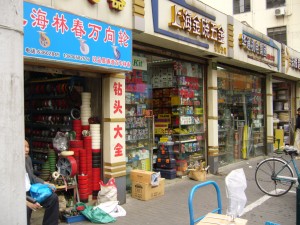
All the widgets and screws and things that aggravate us at Home Depot come from these little shops around our hotel, open 7 days a week for long hours a day.
The subway/metro costs just 7 RMB to go all the way to the airport and takes just about an hour. Very convenient. We met the Expo events manager for Columbia on the train, and it was interesting to hear about Expo life (they all live in a village, like at the Olympics).
This “tour” was a little different in that it was more of a package, and sightseeing tours were not included (they were optional, but we did all of this on our own). Our tour was just $750 each for 9 nights hotel and breakfast, 2 internal flights within China, the Yangtze River cruise (including 3 meals a day), and escorts to/from the airports for our internal flights. 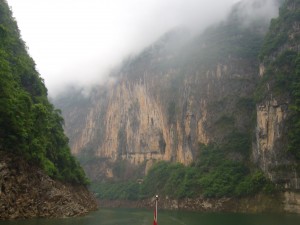
Including our flights (book independently), all our pocket money, all sightseeing, all additional meals, and all incidentals we spent a total of $4,500 for two (half of that was the airfare, and $200 was for our private tour to the Great Wall).
*Beijing city buses: pay the fare (1 or 2 RMB) on board as you enter. They do not make change.
*Taxis and cars are not permitted to stop just anywhere, so if you’re having trouble hailing a cab you are probably standing in a place they are not allowed to stop
*In a supermarket you must weigh your own fruit and place a sticker on it before checkout. If they mutter something inquisitive to you at the register and you don’t have a clue, they are probably asking if you want a plastic bag, for which you will be charged a few pennies
*Beijing is HUGE. What appears to be within walking distance on a map, like just a few blocks, is probably not actually that close. We are tremendous walkers, 10 miles a day is normal for us, so this is not a wimpy American observation. Beijing=big.
*If hiking a remote part of the wall, like we did, consider bringing along an old pair of gloves (or even better, just a single glove, like one whose mate you lost while shoveling snow that winter). You’ll notice many of the hawkers along the wall are wearing gloves. This is so that you can hold onto the side of the Wall for balance as you hike along without hurting your palms.
*consider packing a neck pillow for your long flight, and then you’ll have a supplemental bed pillow (often the hotel pillows are quite hard or flat or uncomfortable in some other way)
*don’t knock yourself out to make way through the crowds at temples or the Forbidden City to see inside. It’s dark and unlit in there, and there’s not much to see, and often the views are obstruction by columns or by dirty/cloudy glass
Amusing Signs
